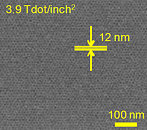Friday, November 26th 2010

Hitachi and Partners Develop New HDD Technology Providing 8-Fold Density Increase
A consortium led by Hitachi, including Japan's New Energy and Industrial Technology Development Organization (NEDO), a public-sector body that promotes research of energy-efficient technologies, National University Corporation Tokyo Institute of Technology, and Kyoto University, have developed a new hard drive data recording technology that promises to increase data density 8-fold.
The researchers have developed a new patterning technology for the magnetized bits that are laid on the platters, which are just 10 nm in size. This is made possible by using new materials, and making use of a self-arranged phenomenon of polymer materials. Its practical applications increases areal-density of disk platters to 3.9 Terabits per square inch, an 8-fold increase compared to the 500 Gigabits per square inch that's currently standard. This paves the way for 24 Terabyte (TB) hard drives in the very near future.
Source:
CDRInfo
The researchers have developed a new patterning technology for the magnetized bits that are laid on the platters, which are just 10 nm in size. This is made possible by using new materials, and making use of a self-arranged phenomenon of polymer materials. Its practical applications increases areal-density of disk platters to 3.9 Terabits per square inch, an 8-fold increase compared to the 500 Gigabits per square inch that's currently standard. This paves the way for 24 Terabyte (TB) hard drives in the very near future.

51 Comments on Hitachi and Partners Develop New HDD Technology Providing 8-Fold Density Increase
Really the floating head design was revolutionary, it has little resistance, fast access time, and is self adjusting, and reliable, plus being cheap. The raptor and server class harddrives show the slowness of a consumer grade hard drive is caused by lower RPM, and the higher access times are half the lower RPM and half the physical size of the platter for sweep time.
What we need is more aerial density, higher RPM, and more platters at smaller diameter. larger discs at higher RPM means more vibration, so smaller discs will allow for the higher RPM, and the higher density will allow for the same or increased storage, more platters means a higher number of bits flying under the heads per second.
Plus the ability to ramp RPM and use a small cheap vibration detecting and tuning device to minimize vibration at maximum RPM would allow for a drive to idle down to slower speeds during low or no demand and then ramp up during high demand.